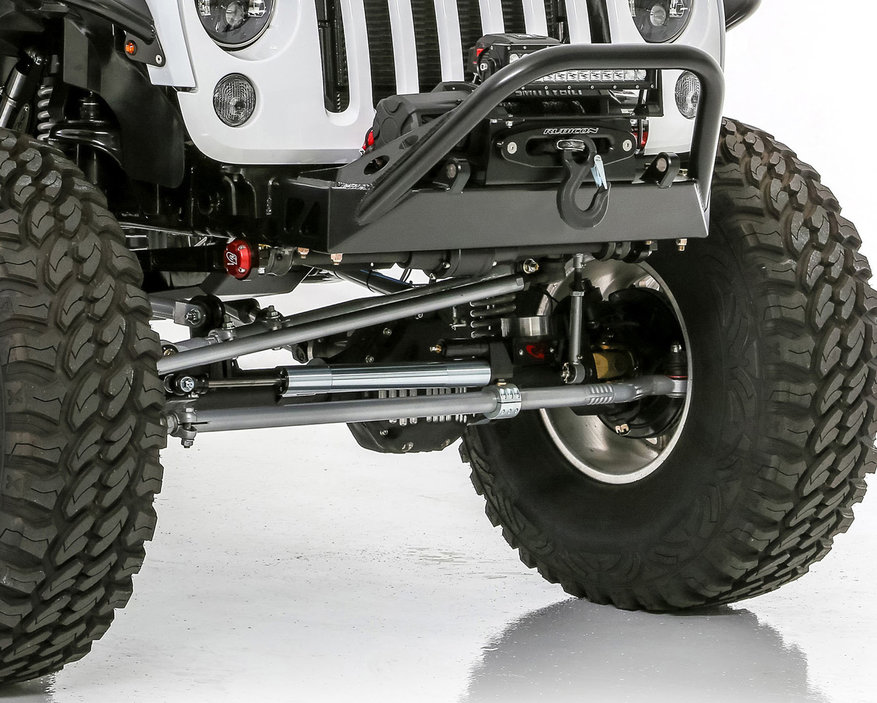by Mike Gardner
Quadratec Channel Correspondent
Out on the trail, lots of things can happen even with seasoned drivers and great spotters. One of those things is steering component damage. After all, a Jeep’s tie rod sits right up front and can take the brunt of an impact when the vehicle slides forward off a rock and into some other hard surface.
And should that happen, it could bend the factory tie rod enough that it impacts the Jeep’s steering.
With so many people building and wheeling their Jeeps these days, it is easy to forget about such an important component when you are focusing on things like lift kits, bumpers, wheels and tires. But making sure a vital steering part is strong enough to withstand different types of trail damage is just as important as that lockers before light bars adage, or recovery before radios.
Now, we’re not saying change the tie rod or suffer the consequences. Not at all. In fact, the factory tie rod is absolutely fine for a smaller lift set ups, and even up to 35-inch tires, as long as the Jeep isn’t being put through the ringer on the trail. Those smaller lifts and light wheeling won’t expose the tie rod to rougher trail conditions, nor will they exact too much stress on those tie rod ends and joints.
However, if the plan is to add a lift over 3” in order to travel on more aggressive trails, then driving and steering with a factory tie rod can certainly become a weak point, as well as another potential cause of death wobble.
Changing out to an aftermarket tie rod is an easy modification and the cost is quite a bit less compared to other important upgrades. Plus, it is certainly more manageable than what repairs would cost should the factory tie rod fail when off-road, forcing the Jeep to be pulled back to the trailhead or towed to a repair shop.
Case in point; Project Grey Wolf was due for a tie rod upgrade following installation of a Rock Krawler 2.5” Off-Road Pro lift kit and 35” Mickey Thompson MTZP3s. Before that upgrade happened, though, it took a bad rock strike during a run on Barney Rubble Trail at Anthracite Outdoor Adventure Area. The impact caused the factory tie rod to bend a bit, luckily not enough to prevent the vehicle from driving, but enough that it could pose a problem down the line as well as affect tire performance.
Project Grey Wolf chose the Steer Smarts YETI Extreme Duty Tie rod for its factory replacement, but in reality there are many solid aftermarket options such as Rock Krawler, Teraflex, Rough Country, Rubicon Express, Synergy, Crown and others.
So what are the real benefits of this upgrade? Well, besides fixing any current factory tie rod issues, aftermarket steering tie rods are engineered with stronger materials—such as chromoly—that end up being quite a bit more lightweight without sacrificing durability. These will also arrive with better tie rod ends and joints that are made with a more durable material, while also sporting an increase in size. This all helps provide the added strength to stand up to trail abuse, while helping prevent steering issues and warding off the effects of death wobble.
For example, looking at the Steer Smarts YETI series. This tie rod is engineered with tubing that is equivalent to stuff found in a class-four truck. It also uses a 1.25” diameter tie rod adjuster and draglink ends that provide a significant increase in strength over the original equipment tie rod. Steer Smarts supplies greaseable 30mm ball joints with the kit that are the largest and strongest ever for the Wrangler JK steering linkage. The ball joints used prevents the linkage from flopping during on or off-road driving for improved steering and component life span. All tie rod ends are forged and heat treated for strength as well as powder coated for added durability and aesthetics.
Other aftermarket tie rods offer many of the same upgrade benefits as well, and can certainly provide peace of mind when upgrading with lift kits and larger tires and/or hitting more aggressive trails.





















